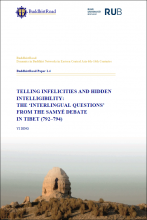BuddhistRoad Paper 1.4 "Telling Infelicities and Hidden Intelligibility: The ‘Interlingual Questions’ from the Samyé Debate in Tibet (792–794)"
Synopsis
This article revisits two texts relevant to the so-called Samyé Debate, which presumable took place in the late 8th century between Chinese monk Moheyan (fl. second half of 8th c., 摩訶衍) and his Indo-Tibetan opponents. They are the Dunwu dasheng zhengli jue 頓悟大乘正理决 [The Judgement on Sudden Awakening Being the True Principle of Mahāyāna] in Chinese and the Tibetan equivalent of the ‘old questions’ and Moheyan’s answers. This article argues that lexical and grammatical infelicities can be used to reveal the interlingual nature of the questions and answers in these two texts. Whereas Moheyan’s answers were originally composed in Chinese and translated into Tibetan, the questions were originally formulated in Tibetan and translated into Chinese. The language barriers did not cause a breakdown in communication, as the two sides of the debate could manage to understand each other well via Tibetan as a written language.
Chinese Translation
本文再考了与所谓的 “桑耶僧诤” 有关的两件文本, 据推测, 该辩论发生在8世纪末的汉地僧人摩诃衍和他的印藏对手之间. 这两件文本是汉文的《顿悟大乘正理决》(The Judgement on Sudden Awakening Being the True Principle of Mahāyāna) 和相应的藏文本中的 “老议题” 及摩诃衍的回答. 本文认为, 词汇和语法的不规范性揭示了这两个文本中问答的跨语言性质. 摩诃衍的回答最初是用汉语写的, 后翻译成藏语, 而问题最初是用藏语写的, 随后翻译成了汉语. 语言的障碍并没有导致交流的中断, 因为辩论的双方可以通过藏语这种书面语言很好地理解对方.

Downloads
Published
Categories
License

This work is licensed under a Creative Commons Attribution-NonCommercial-NoDerivatives 4.0 International License.

